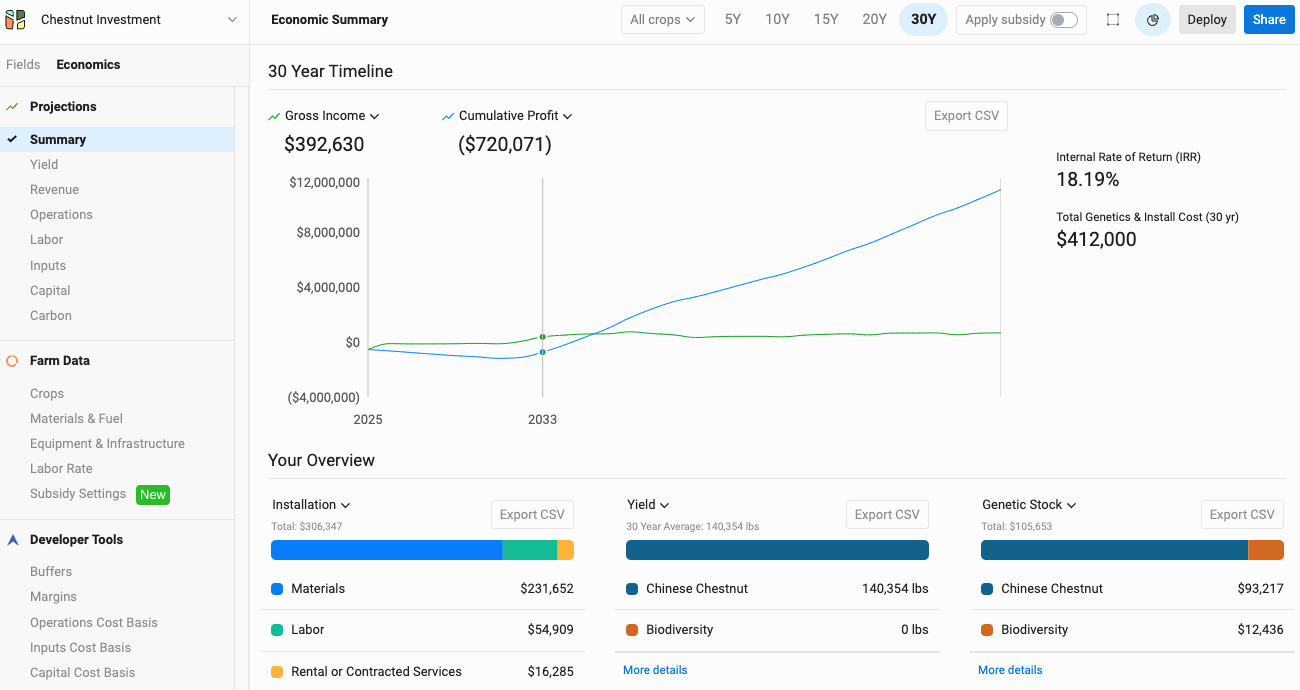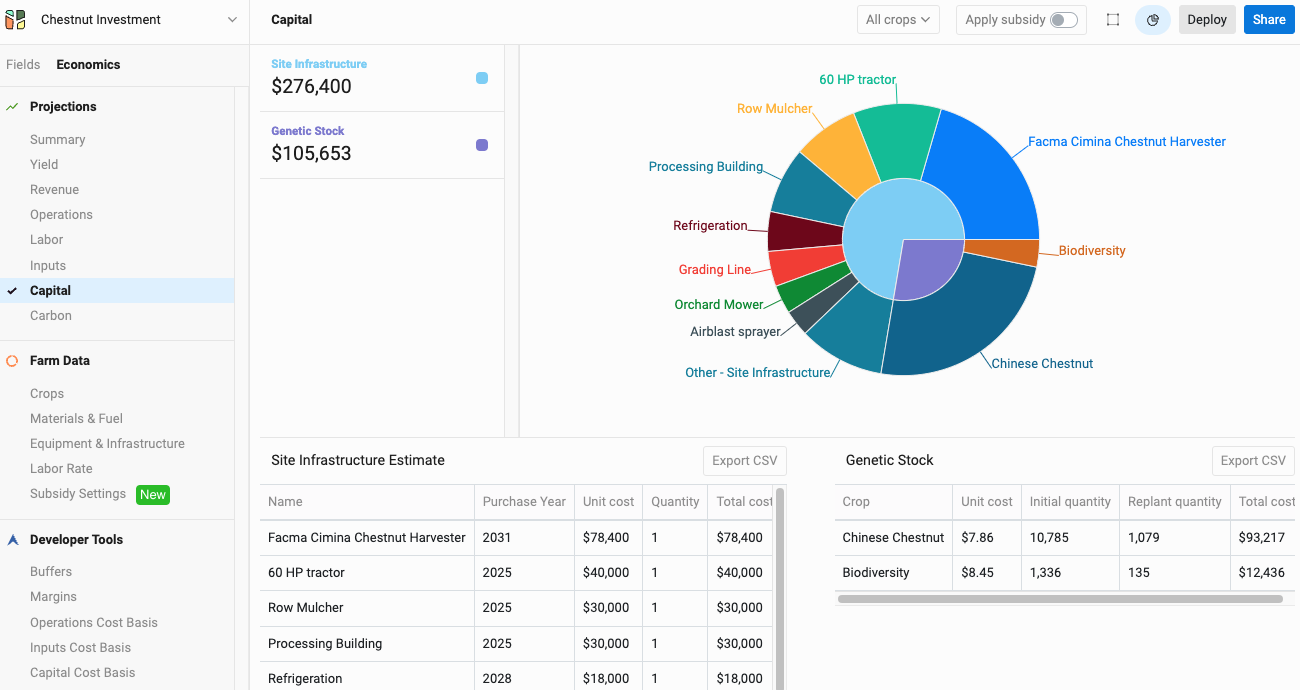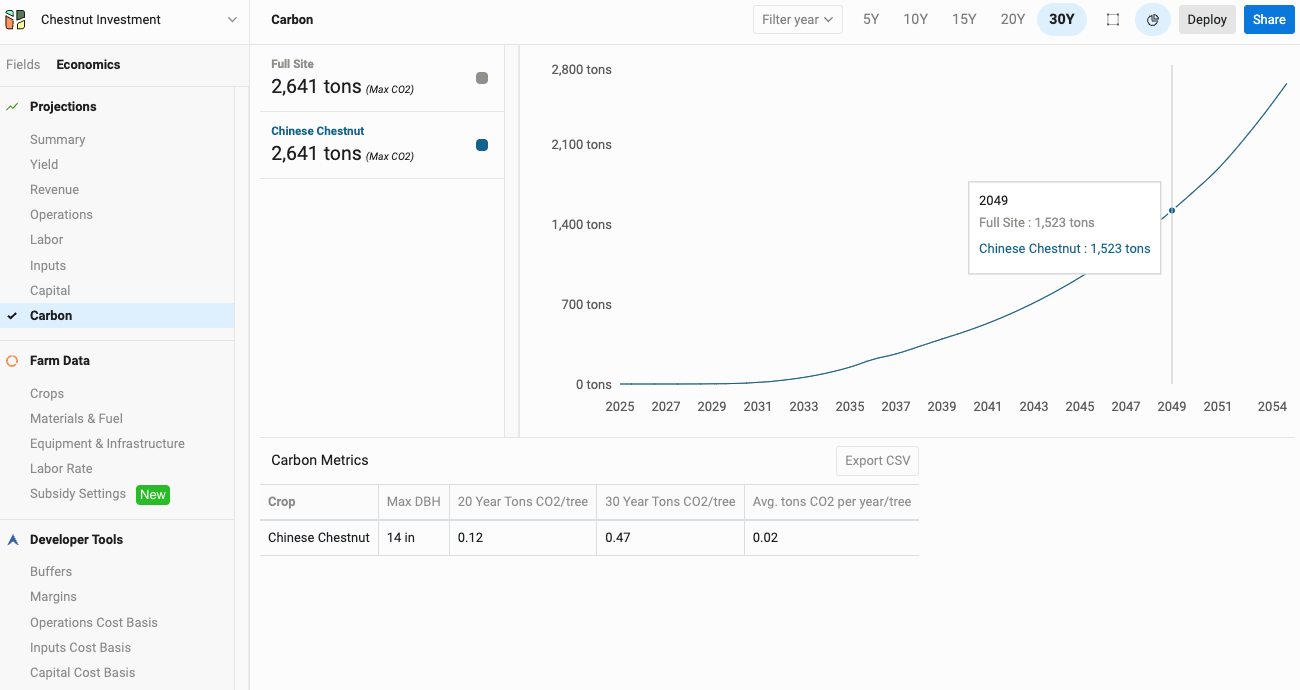Why Investors are Turning to Tree Crops for Farmland Assets
Investment managers are funneling capital into U.S. farmland at an increasing rate. Since 2008, the number of properties owned by such firms has increased 231% according to NCREIF's quarterly farmland index. Why? Farmland is resilient to inflation, offers stable returns through land leases and has limited downside risk.
With the increased attention comes fresh ideas to develop the asset class. Propagate works with asset managers to understand, plan and manage investments in permanent tree crops. Mostly nut and timber producing trees grown in agroforestry systems. These practices enhance the value of farmland and provide a number of other ecosystem benefits. I’ll share more about what we’ve learned that make a compelling case for tree crop investments.
In short:
Tree crops generate more profit per acre than conventional row crops, increasing cash yield
When planted and managed well, trees improve farmland and livestock conditions in ways that further mitigates investment risk
Agroforestry practices provide valuable ecosystem services that aid in sustainability commitments, hedge risk against future regulations, and in some cases can be monetized for additional income
Why Tree Crops?
Increasing cash yield
Incorporating trees with crops and livestock increases overall cash yield per acre. This is done with strategies like alley cropping, silvopasture, and windbreaks which complement existing crop yields and introduce new streams of income through fruit, nuts or timber. The key idea is understanding which tree species have attractive supply-demand dynamics and grow well in a particular plot of land. Our team specializes in finding the overlap of value and suitability. We have developed software to help plan these investments, allowing you to forecast the economics of agroforestry projects.
Let’s look at a concrete example to show the case. Consider a corn soy rotation compared to alley cropping with Chinese chestnut and hay. In this case the revenue per acre can increase at least 5 times.
Reduce investment risk
Asset managers bear a heavy responsibility to mitigate risk in their investments. Understanding the details of any practice change are critical to making decisions for farmland operations. When evaluating agroforestry, it’s important to note that trees which are intentionally planted, and managed well can reduce a farm’s operational risk — ultimately reducing investment risk. This is especially true when agroforestry practices are used to complement other crops and livestock. Risk reductions can be found in a combination of:
Income diversification from the sale of fruit, nuts, or timber
Improved crop and livestock productivity from the benefits trees provide (soils and shade), leading to stronger operational margins
Ecosystem benefits that can be monetized like carbon sequestration from tree biomass
Ecosystem benefits that ensure compliance with current or future requirements like water quality
I’ll share more details on the ecosystem benefits later, but here are two examples to illustrate the points above.
Example: Trees can improve soil health by reducing wind erosion and improving nutrient retention. These effects can increase yield in neighboring crops. These benefits are documented in research from the USDA.
Example: In the case of livestock. Grazing among trees provides shade and prevents weight loss through heat stress. A study in Florida showed that the average daily gain of heifers increased 0.47 lbs/day compared to those in direct sun.
Agroforestry is not without its own risks. As with any crop, survivability can be a concern. That is why we place an emphasis on proper planning, planting & management to ensure project success. Propagate ensures an 80% survival rate on our projects. To date, our work has beaten this expectation.
Align with values sustainability commitments
More than half of global asset owners are currently implementing or evaluating ESG considerations in their investment strategy. This is happening for a number of reasons, such as increasing shareholder focus and risk diversification, but one stood out to me in a report from Morgan Stanley. It showed that in the first half of 2023, sustainable funds saw a median return of 6.9%, beating traditional funds’ 3.8%.
Tree crops are a fantastic option for agricultural asset managers looking to meet existing commitments, or plan strategies to align with future goals. Growing trees in agroforestry practices are part of a holistic approach to sustainable agriculture which allows investors to show measurable impacts to their stakeholders in a number of areas:
Carbon sequestration
Water quality
Biodiversity
Supporting rural communities
More on agroforestry co-benefits
Many of the economic outcomes, risk reductions, and means to progress toward sustainability goals are supported by the co-benefits of agroforestry. I’ve outlined the basics for them, but recognize that each deserves their own deep consideration. Asset managers and farm operators are making decisions that impact performance for future generations, and will need to know there is supporting evidence and well-established support systems to realize these aspirational outcomes.
I’ll share a few resources to help guide further investigation. Propagate has proudly built on the research being done in these areas. We’ve partnered with organizations like Rodale Institute and The Nature Conservancy to show what tree crops grown in agroforestry can do for our future.
Soil health & agroforestry: USDA
Water quality: USDA
Improved conditions for livestock: The Nature Conservancy & Propagate
Biodiversity: The Center for Agroforestry, School of Natural Resources, University of Missouri
Carbon: USDA
At the end of the day, it’s important to consider agroforestry as a specific set of tools that can generate positive outcomes based on your unique goals. Our team is here to help you conceptualize designs specific to your land using Overyield, showcasing economic forecasts, and discussing ecological impact scenarios. We’ve recently added carbon sequestration estimates into the tool as well.
What success looks like
As with any agricultural practice, there is a range of return based on performance. Performance in agroforestry is determined by a number of factors like:
Proper farm planning
Procuring high-quality nursery stock
Experienced implementation partners
Ongoing farm management
Achieving the highest returns and level of risk reduction hinges on the quality of the partner(s) you work with. Costs can compound with improper planning and management. This is why our team is focused on solving for every part of planning, planting and ongoing management to ensure project success. We simplify the process from end to end so you work with a single partner, and we back up our work with guarantees for survivability to further de-risk investments.
Case study
Learn how our team worked with Keavin Hill, owner of Hill Farms in central Ohio, to create what is now the largest chestnut operation in the United States. Hill recognized an opportunity to meet a growing and underserved demand for domestically-produced chestnuts and wanted to act. With Propagate’s support, he converted 1,850 acres of his farmland from corn, soy, and wheat to chestnut and hay production since spring 2022.
Ready to get started?
Understanding what is possible on a single property, or collection of properties in aggregate has never been easier. Our team is equipped to plan projects at scale with multi-farm features in Overyield. Simply share some information with us about potential locations and your investment goals, and we can provide actionable options for you to explore.
Contact our team




